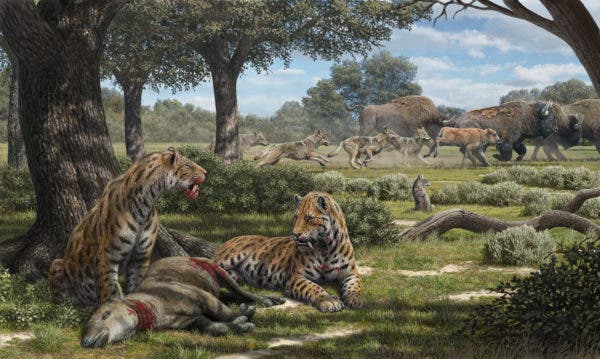Usually described as fierce predators, saber-toothed cats are imagined as stalking the open savannah in pursuit of bison, horses and other grassland-dwelling prey. But a new study paints a much less fierce image of the now long-extinct animals.

A team of researchers led by Vanderbilt University’s Larisa DeSantis recovered fossils from the La Brea Tar Pits in California, which suggested that the up to 600-pound cat actually preferred hunting in the forest, were easy targets, including tapirs and deer, congregated. The work was published in the journal Current Biology.
Based on an analysis of more than 700 fossil teeth belonging to multiple prehistoric species, the findings contradict the idea that competition among carnivores drove saber-toothed cats and other megafauna to extinction some 10,000 to 12,000 years ago.
“The cats, including saber-toothed cats, American lions, and cougars, hunted prey that preferred forests, while it was the dire wolves that seemed to specialize on open-country feeders like bison and horses,” DeSantis explained. “While there may have been some overlap in what the dominant predators fed on, cats and dogs largely hunted differently from one another.
The scientists’ research pinpoints a different explanation for the giant cat’s demise, positing that factors, including climate change and an uptick in nearby human populations, which precipitated the species’ eventual extinction. Smaller predators such as coyotes, on the other hand, weathered harsh conditions.
DeSantis and her colleagues arrived at their conclusions by studying microscopic patterns of wear on fossil teeth, as well as the proportions of two carbon isotopes found within tooth enamel. These isotopes, passed along from plant-eating prey to carnivorous predators, identify victims’ preferred habitat as open versus forested environments.
The La Brea Tar Pits, bubbling pools of natural asphalt that attracted predators and prey alike, have yielded more than 3.5 million specimens representing some 600 species. Most of these unlucky animals were carnivores lured in by the carcasses of horses, bison, and camels already caught in the tar; rather than escaping with an easy meal, the predators soon found themselves similarly stuck.

Previous research had focused on carbon and nitrogen isotopes found within a bone protein called collagen. These analyses concluded that prehistoric predators from saber-toothed cats to dire wolves and American lions hunted in open environments, competing for the same limited pool of prey.
“When we look at the enamel, we get a totally different picture,” DeSantis said. “We find that the saber-tooth cats, American lions, and cougars are actually doing what cats typically do, which is hunting within forested ecosystems and using cover to potentially ambush their prey.






